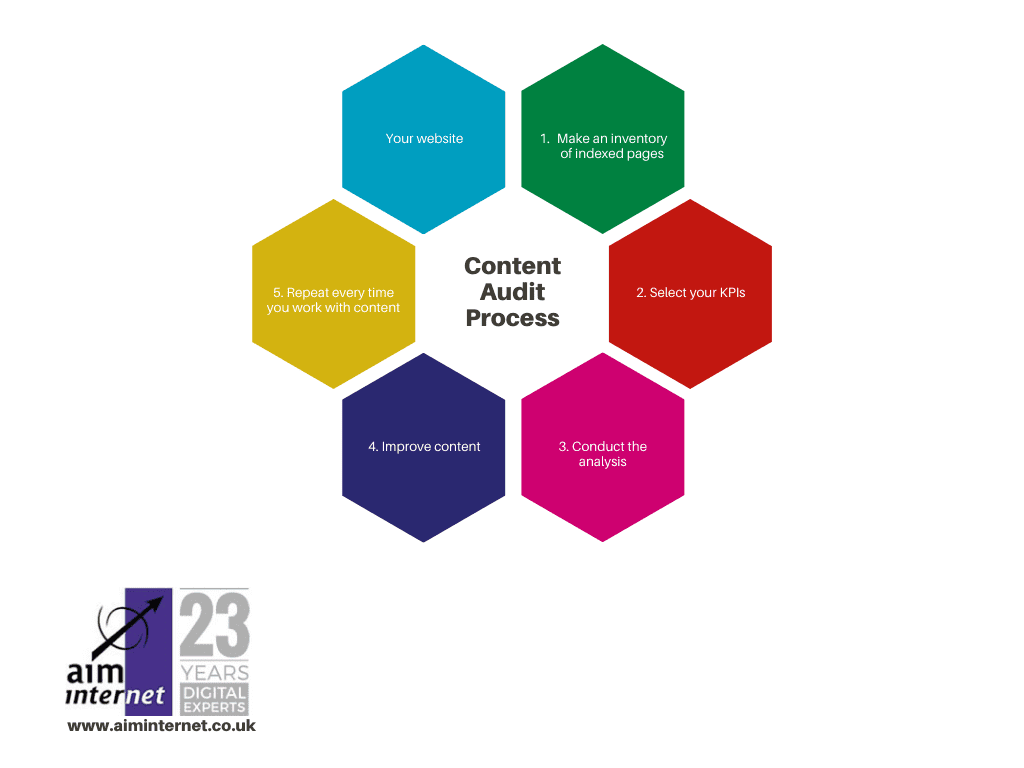As your company grows, so does your content library. We hear over and over again how important it is to create fresh, relevant content to help educate and entertain our customers. But, it’s just as important to audit your content once in a while. Trends change and so do your business goals so you need to make sure your content aligns with these. For instance using is a website content audit checklist can help you get started.
A content audit is one of the best investments of your time when it comes to improving your website. And before you can move forward with a new content strategy, it’s important to audit the content you already have. Sometimes the best strategy is simply repurposing older content to bring it up to scratch.
An effective content audit means going through all of the content you have previously published. Anything from blogs, videos, images, infographics, manuals, guides, anything your customer can access. Yes, this is a timely process but it’s absolutely worth the grind. We’re here to teach you the benefits of a content audit and how to do it in a timely and effective manner.
Content Audit Process
Here’s a very quick glance at the stages of a website content audit. Keep reading to find out exactly how to improve your website content.

Why You Need To Do A Content Audit
As we mentioned earlier, a content audit is a lot of work, so can you get away without doing one? The answer, as you’d expect, is no. There are no end of benefits that come from taking a comprehensive look at your existing content. An important one being it helps identify any functional issues with you site such as broken links or slow site speed times.
It will also help you iron out any issues with the site’s usability and navigation. It’s not unusual to stumble across other issues while performing a content audit. This is a good thing, as it means you can put them right. You want to make sure the great content you’re producing can easily be found by the user.
By auditing your content you can also improve your SEO. It gives you the opportunity to check you have done everything you can to optimise the content. Whether it’s keyword, meta descriptions, links, etc. These small tweaks can drastically improve your organic SEO rankings.
Website Content Audit Checklist
While performing your content audit you need to be asking certain questions to ascertain the quality of your existing content. Here are a few examples of the types of questions you should be asking to start your is a website content audit checklist:
- Does the content add value to my customers?
- Does the content look good?
- Is the content easy-to-read?
- Does the content have relevant internal links?
- Is the content relevant?
- Have you already covered this topic?
- Is the content missing relevant information?
Let’s go into a little more detail.
Does The Content Add Value?
If you ask yourself this question and the answer is no, then you don’t need the content on your website. Any content you create should aim to either inform, entertain or engage your customer. So before you publish a piece of content (or leave content live on your site), ask yourself whether your target audience will be interested? Will they find it useful? If the answer is no, then you need to improve the content or remove it.
Does The Content Look Good?
People make up their minds about a site within seconds of landing on a page, so first impressions count. If your content is visually pleasing people are more likely to stay and read it. Which leads me onto the next point…
Is The Content Easy-To-Read?
Content needs to be easily digestible to keep people’s attention. This means not only should it look good but it should read well too. Always keep your target audience in mind when creating content. Will your target audience relate / understand the content?
Does The Content Have Relevant Internal Links?
Internal linking is extremely important for search engine optimisation but it’s also a really great way to get more of your content seen. If you link related topics within your content the user can find everything they want without having to go searching for it. For example, if you have written a blog on trending hairstyles, you might also link to a blog about how to choose the right hairstyle for your face. You wouldn’t link to a blog on a completely different topic. While this seems like common sense, it’s not uncommon so make sure you’re not making this mistake.
Is The Content Relevant?
This is absolutely essential. The content you deliver has to be relevant to the products or services your offer. Not only should it be relevant, it should be part of a carefully planned marketing strategy for your business.
If it has no relevance and doesn’t add value to those who read it then it shouldn’t be on your website. It may be that the content was once valuable but is no longer relevant or it’s outdated; in this instance either update it or remove it.
Have You Already Covered This Topic?
Although you want to make sure you cover valuable topics thoroughly, you don’t want duplicate content as this can be very damaging to SEO rankings. Google penalises websites that has the same content on multiple pages, which will negatively impact your SEO rankings. You can always take advantage of one of the many tools out there to help you identify duplicate content in a more timely manner.
Is The Content Missing Relevant Information?
When you go back over your content, it’s a great opportunity to notice if anything is missing from it. Ask yourself if you have any questions after reading it? Is there a natural follow on topic that you should link to? Has there been any new information on the topic since you first created it? Do you have more insight to offer now? Picking up on any missing, relevant content is one of the greatest benefits of a content audit. After all, you want your content to offer the most value to your audience. A key thing to check is that the content delivers on the promise of the title. The most annoying thing for a user is to click through on to something that then doesn’t answer the question or give them the information they were looking for based on the title.
Go The Extra Mile
You’re already putting in the hard work to make sure your content is up to scratch, so you may as well go the extra mile. As well as creating a website content audit checklist, check out what your competitors are up to. See what’s working for them and if there’s anything you’re missing out on content wise. A competitor might have some really great content about a topic you haven’t even touched on but is valuable to your industry. The goal is to cover all bases when it comes to your subject matter.
What’s The Next Step?
While you are going through all of your content you need to evaluate each piece and categorise into one of the below options:
- Delete. If the content is no longer relevant, outdated, cannot be repurposed (which is recommended) or does not add value to your site you should delete it. Poor quality content will only damage your SEO ranking and authority.
- Improve. Ideally, you’ll be able to improve and repurpose most of your content, as the more content you have on your site the better it is for ranking. However, this is only true of high quality content. To improve your content might include increasing the word count, adding relevant updates, adding keywords, including internal and external links and checking sentence length and readability.
- Keep. In an ideal world you will have plenty of great content that doesn’t need any improving. All you need to consider for this content is how you’re going to market it and make sure people see it. Don’t worry if the scales favour the improve category, industries are continuously evolving which means so is the need for your content.
- Create. As mentioned earlier, a content audit is a great opportunity to spot any gaps in your subject areas. This may be a completely new topic that you hadn’t thought of before but your competitors have covered extensively. Or, answers to questions that arose when you were going back over the content. Your aim is to make sure the reader leaves your site with all the information they are looking for and without the need to search elsewhere.
Related: How To Reverse Engineer Your SEO and Content Strategy
In Conclusion
A content audit is not a small job but it is essential to your SEO and for maintaining an authoritative voice in your industry. It’s important to strategise how you’re going to do it before jumping straight into it. If you don’t come up with a plan of how you’re going to tackle the audit before starting, it may seem overwhelming. Break it down into manageable sections by using a website content audit checklist like the one above.
By categorising your content based on whether you will delete it, improve it, keep it or create new content, you are already making your life a lot easier. Then, you simply need to work your way through the evaluations you have made.
There is no getting around the fact the content audit will be a time consuming process, but it will be worth the investment for SEO purposes. Not to mention the satisfaction of knowing your site is populated with high quality content that only adds value to your audience. And once you’ve done it the first time, each time after that will be easier.
You may also be interested in Building an Online Presence: Why you Need to Audit your Website

